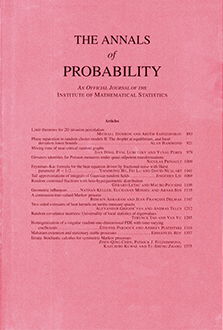Abstract
Consider the following mechanism for the random evolution of a distribution of mass on the integer lattice Z. At unit rate, independently for each site, the mass at the site is split into two parts by choosing a random proportion distributed according to some specified probability measure on [0, 1] and dividing the mass in that proportion. One part then moves to each of the two adjacent sites. This paper considers a continuous analogue of this evolution, which may be described by means of a stochastic flow of kernels, the theory of which was developed by Le Jan and Raimond. One of their results is that such a flow is characterized by specifying its N point motions, which form a consistent family of Brownian motions. This means for each dimension N we have a diffusion in RN, whose N coordinates are all Brownian motions. Any M coordinates taken from the N-dimensional process are distributed as the M-dimensional process in the family. Moreover, in this setting, the only interactions between coordinates are local: when coordinates differ in value they evolve independently of each other. In this paper we explain how such multidimensional diffusions may be constructed and characterized via martingale problems.
Citation
Chris Howitt. Jon Warren. "Consistent families of Brownian motions and stochastic flows of kernels." Ann. Probab. 37 (4) 1237 - 1272, July 2009. https://doi.org/10.1214/08-AOP431
Information





